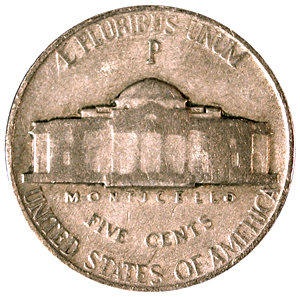U.S. Coins Change for Wartime
|
"Making Cents"
The Signal
Saturday, July 9, 2005
| W |
Scrap metal drives were common during the war. All auto makers stopped the production of cars during the war and turned their resources to military needs such as trucks, tanks, jeeps and weapons.
The U.S. Mint was asked to conserve, if not eliminate, the use of bronze (copper alloy) during the war. Several alternative metals were offered, such as aluminum and stainless steel, but in 1943 the mint settled on a zinc-coated steel alloy.
These newly minted steel cents looked much like dimes at a glance, and they were magnetic. That meant they would not work in penny vending machines; there were many types of one-cent vending machines at the time, including gum machines in almost every subway station in New York.
During its short tenure, citizen complaints forced the one-year issue to be replaced in 1944. Most of the steel cents that remained in circulation developed rust, spotting, whitish oxide of zinc, and often turned black.
The mints requested that spent military shell casings, mostly naval ordnance, be recycled and used for coinage, since the shell casings were also made of a brass alloy like the cent. In 1944 and 1945, the mints produced billions of the shell-case cents which, at a glance, looked just like the pre-war bronze cents. However, many had colorful greenish and yellowish streaks, or even thin black lines.
Later analysis showed that the ingredients in the explosives, such as phosphorus and manganese — even in minuscule traces — can discolor the alloy. Even today, most "brilliant uncirculated" specimens of 1944 and 1945 cents show these colors. By 1946, the mints returned to commercial bronze strips for coining cents.
In October 1942, the mints introduced the wartime nickel composition, an alloy of 56 percent copper, 35 percent silver and 9 percent manganese — allowing supplies of nickel to be diverted to military uses.
The alloy proved only a short-term solution, as these coins were plagued by laminations and black streaks, and they tarnished rather readily. To distinguish this alloy from the prewar nickel alloy, a large mint mark was placed above Monticello, including a "P" for Philadelphia, used for the first time on any coinage.
There are 11 different wartime nickels, which are quite collectible and not that expensive, since many rolls of mint specimens were stored for speculation. Uncirculated sets are readily available from many dealers. By mid-1945, the prewar alloy was prepared for the 1946 issues and the wartime composition was discontinued.
An interesting counterfeit 1944 wartime nickel made the rounds in the Northeast without the "P" mint mark. Hundreds of specimens were found, and all were traced to a local counterfeiter who was unaware of the mismatch. His alloy matched closely the genuine alloy, and had he included the "P" mint mark, his coins never would have been detected. After all, who would make fake nickels?
Today, circulated wartime nickels bring a premium over face value just for their silver content, varying in price with the market value of silver.
The three mints produced usual numbers of silver dimes, quarters and half dollars during World War II, even with reduced manpower and scarcer resources.
Dr. Sol Taylor of Sherman Oaks is president of the Society of Lincoln Cent Collectors and author of The Standard Guide to the Lincoln Cent. Click here for ordering information.
©2005, THE SIGNAL · ALL RIGHTS RESERVED.
